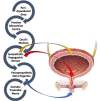Anatomical Aspects of Neurogenic Bladder and the Approach in Its Management: A Narrative Review
- PMID: 36483903
- PMCID: PMC9725102
- DOI: 10.7759/cureus.31165
Anatomical Aspects of Neurogenic Bladder and the Approach in Its Management: A Narrative Review
Abstract
The contraction of the detrusor muscle causes the urinary bladder and its mass peristaltic movement, leading to micturition. The vesical plexus of nerves, composed of fibers from the inferior hypogastric plexus, supplies the urinary bladder. The brain plays a crucial part in developing and maintaining bladder control, although its specific involvement in urgency and urine leakage is not well understood. The critical components in the neural control of the bladder and its regulation are the pontine micturition center (located in the mediodorsal aspect of the pons) and the Onuf's nucleus, also known as the sacral micturition center (located between the sacral S2 and S4 segments). The most important cause of a neurogenic bladder is damage or lesions of the spinal cord affecting the pontine micturition center, Onuf's nucleus, or damage to the motor neurons between the pontine and the sacral centers of micturition. Neurogenic bladder can be of several types based on the location of the lesions, such as the autonomous bladder, spastic bladder, atonic bladder, and cortical bladder, all were presented with a unique clinical picture. The classical approach to a case of neurogenic bladder involves a complete assessment of the neurologic system and of pelvic anatomy, while neurogenic bladder rehabilitation may include a bladder retraining program involving intermittent catheterization, timed voiding, medications, and lifestyle modifications. This review article attempts to correlate the neurogenic bladder with various anatomical aspects related to the micturition center in the brain and spinal cord and their control over the urinary bladder, as well as the classical approach toward such a case of neurogenic bladder.
Keywords: atonic bladder; autonomous bladder; cortical bladder; neurogenic bladder; onuf's nucleus; pontine micturition centre; spastic bladder.
Copyright © 2022, Kumar et al.
Conflict of interest statement
The authors have declared that no competing interests exist.
Figures
Similar articles
-
Two pontine micturition centers in the cat are not interconnected directly: implications for the central organization of micturition.J Comp Neurol. 1999 Jan 11;403(2):209-18. doi: 10.1002/(sici)1096-9861(19990111)403:2<209::aid-cne5>3.0.co;2-x. J Comp Neurol. 1999. PMID: 9886044
-
[Lower urinary tract function and its disorders].Cesk Fysiol. 2000 Aug;49(3):134-44. Cesk Fysiol. 2000. PMID: 11039243 Review. Czech.
-
Sophisticated regulation of micturition: review of basic neurourology.J Exerc Rehabil. 2021 Oct 26;17(5):295-307. doi: 10.12965/jer.2142594.297. eCollection 2021 Oct. J Exerc Rehabil. 2021. PMID: 34805017 Free PMC article. Review.
-
Central nervous control of micturition and urine storage.J Smooth Muscle Res. 2005 Jun;41(3):117-32. doi: 10.1540/jsmr.41.117. J Smooth Muscle Res. 2005. PMID: 16006745 Review.
-
Micturition and the soul.J Comp Neurol. 2005 Dec 5;493(1):15-20. doi: 10.1002/cne.20785. J Comp Neurol. 2005. PMID: 16254993 Review.
Cited by
-
Latent classes analysis and associated factors of knowledge of intermittent catheterization in neurogenic bladder management among medical staff.Sci Rep. 2025 Apr 2;15(1):11319. doi: 10.1038/s41598-025-96362-3. Sci Rep. 2025. PMID: 40175610 Free PMC article.
-
Exploring urinary microbiome: insights into neurogenic bladder and improving management of urinary tract infections.Front Cell Infect Microbiol. 2025 Apr 1;15:1512891. doi: 10.3389/fcimb.2025.1512891. eCollection 2025. Front Cell Infect Microbiol. 2025. PMID: 40235931 Free PMC article. Review.
-
Changes in the Urethral Artery After Experimental Subarachnoid Hemorrhage-Induced Injury of the Pudendal Ganglion and Onuf's Nucleus Junction.Eurasian J Med. 2023 Oct;55(3):239-242. doi: 10.5152/eurasianjmed.xxx. Eurasian J Med. 2023. PMID: 37909197 Free PMC article.
-
Neurogenic Bladder in Children with Myelomeningocele.Diseases. 2025 Apr 17;13(4):117. doi: 10.3390/diseases13040117. Diseases. 2025. PMID: 40277827 Free PMC article. Review.
References
-
- The striated urogenital sphincter muscle in the female. Oelrich TM. Anat Rec. 1983;205:223–232. - PubMed
-
- The urethral sphincter muscle in the male. Oelrich TM. Am J Anat. 1980;158:229–246. - PubMed
-
- Neuroanatomy of the lower urinary tract. Beckel JM, Holstege G. Handb Exp Pharmacol. 2011:99–116. - PubMed
Publication types
LinkOut - more resources
Full Text Sources


